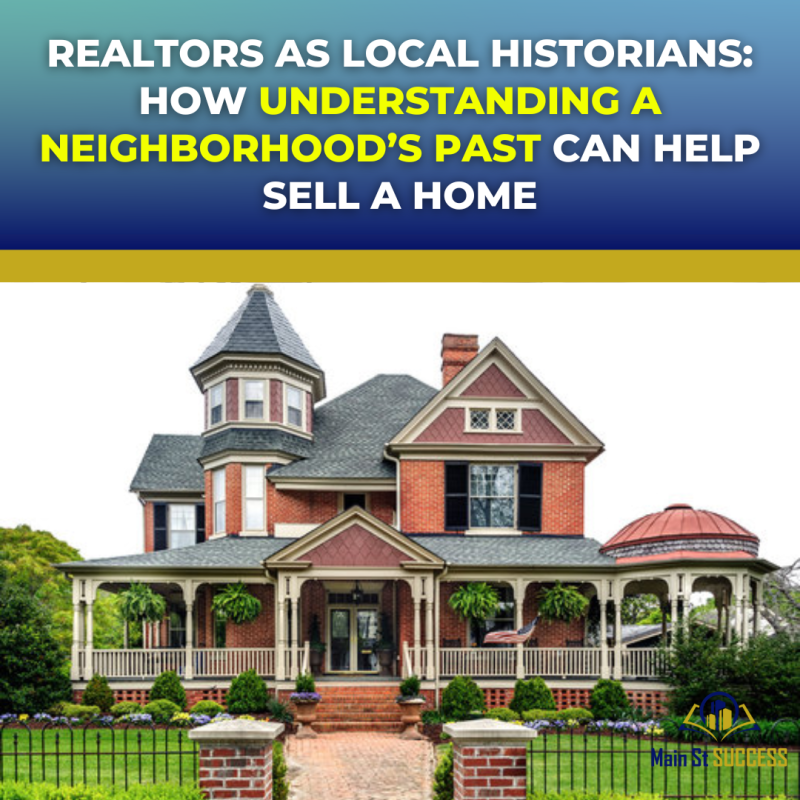Blog
Realtors as Local Historians: How Understanding a Neighborhood’s Past Can Help Sell a Home
In today’s competitive real estate market, selling a home goes far beyond just showcasing its features. Buyers are no longer only concerned with the number of bedrooms or the quality of the countertops—they want to know about the neighborhood, its history, and what it represents. Understanding the past of a community can be a powerful tool for realtors, helping them position a home in a way that resonates with potential buyers. In this article, we explore how realtors can act as local historians, using the rich tapestry of a neighborhood’s history to sell homes.
Why History Matters in Real Estate
When prospective buyers walk through a home, they’re not just imagining how the space will function for their family—they’re also considering the life they’ll lead in the surrounding community. Whether it’s a quiet suburban street, a historic district, or a rapidly gentrifying area, the neighborhood’s history often shapes the buyer’s emotional connection to the place.
Real estate is about much more than bricks and mortar; it’s about the story the home and its surroundings tell. A neighborhood’s past gives context to the present and helps buyers envision their future in the area. Understanding the local history can help realtors provide a unique narrative, making the home more appealing to buyers who value the character, stories, and traditions behind their future residence.
Building Trust Through Knowledge
For a realtor, knowing the history of the neighborhood can make a big difference in building trust with potential buyers. Buyers are often wary about investing in a home without knowing everything about the area, including its cultural significance, past challenges, or successes. When a realtor can speak confidently about the local area’s history, it shows that they’re not just selling a property—they are invested in the community.
For instance, if the area has a rich history of being a hub for artists, highlighting this fact can appeal to buyers looking for creative energy. Alternatively, if a neighborhood has a history of excellent schools or has been revitalized in recent years, these insights can be incredibly appealing. When a realtor is knowledgeable about the area, buyers feel more confident and trust that they are making an informed decision.
Storytelling: A Powerful Selling Tool
One of the most effective ways to highlight a neighborhood’s history is through storytelling. Realtors can use the unique narrative of an area’s past to create a connection between the home and potential buyers. This doesn’t mean reciting dry facts or listing historical milestones—it’s about weaving a compelling story that helps buyers visualize what life might be like in the neighborhood.
For example, if the neighborhood was once home to a famous figure, such as a beloved author or local hero, that information can be woven into the home’s story. Realtors can share anecdotes about the area’s early days, famous events, or notable figures that have left their mark on the community. This can transform a simple house tour into a more immersive experience, helping buyers connect emotionally to the property.
Real estate is, after all, about selling more than just a physical space—it’s about selling a lifestyle. Understanding the history of a neighborhood allows realtors to position homes as part of a larger narrative, making the property feel like a place where buyers can become part of something meaningful.
The Role of Architecture in Local History
In many cases, the architecture of a neighborhood tells its own story. Older homes may have been built during specific historical periods, and they often feature architectural details that reflect the style and trends of the time. For example, homes in neighborhoods with a strong Victorian influence may appeal to buyers who are drawn to period features such as intricate woodwork, grand staircases, or bay windows.
Realtors can use the architectural style of a home as a point of connection with the area’s history. By highlighting how the design of a home fits within the larger context of the neighborhood’s development, realtors can provide deeper insights into the home’s cultural significance. Whether it’s mid-century modern homes in a newly gentrified area or colonial-style homes in a historic district, linking the architectural style to the neighborhood’s evolution can make the property feel more unique and special.
Gentrification and Revitalization: An Important Element of Local History
Understanding the history of gentrification or revitalization in a neighborhood is another important element for realtors to consider. As urban areas continue to evolve, many neighborhoods undergo significant changes in terms of demographics, infrastructure, and development. These shifts can have a major impact on the real estate market.
Realtors who understand the dynamics of gentrification—whether the area is in the early stages of change or has already undergone significant redevelopment—can offer valuable insights to buyers. If an area was once considered underdeveloped or struggling but is now flourishing due to investments in public infrastructure or an influx of businesses, highlighting this transformation can make the neighborhood feel like an exciting and prosperous place to live.
By knowing the history of the revitalization efforts, realtors can explain the factors that have driven the positive changes in the area and how this affects property values, safety, and overall community life. This knowledge is not only important for attracting buyers but also for helping them feel confident about the long-term value of their investment.
Local Landmarks and Cultural Significance
Every neighborhood has landmarks—whether they’re historic sites, popular local restaurants, parks, or community centers—that contribute to the area’s charm and identity. Realtors who know the history of these places can add depth to their property showings, discussing how these landmarks play an integral role in the local culture.
For instance, if the home is located near a historic park or an iconic restaurant, a realtor can share the significance of these places in the community’s history. Mentioning how local landmarks have helped shape the area’s identity can help buyers feel like they are becoming part of something special. It also allows realtors to highlight the value of living near these cherished spots, whether they offer convenience, recreation, or a sense of pride for the community.
How to Research a Neighborhood’s History
To be effective local historians, realtors need to do their homework. Thankfully, there are many resources available to help uncover the history of a neighborhood:
- Local archives and libraries: Many cities have archives or historical societies that maintain records, maps, and documents about the area’s past.
- Local museums: Museums often feature exhibits about the history of the town or city, offering valuable insights into its development.
- Talking to longtime residents: Longtime residents can provide firsthand accounts of the neighborhood’s history and share personal stories that aren’t found in books or archives.
- Online resources: Websites such as local government pages, historical databases, and social media groups dedicated to the community can provide an abundance of information about the area’s history.
By conducting thorough research, realtors can ensure they are sharing accurate and relevant historical details with their clients.

